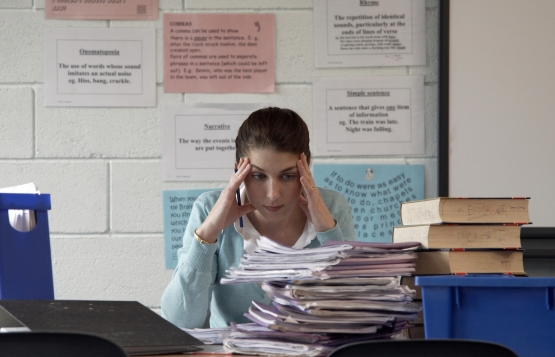When I was the superintendent of an urban charter school district, we saw in our classrooms every day what our data confirmed and decades of research told us: The quality of the classroom teacher is the largest determinant of student outcomes. Great education requires great teachers. If we had been able to retain our best teachers each year and replace the least effective ones with educators of just average effectiveness, our student outcomes would have soared. Unfortunately, the existing system makes that impossible, even in charter schools.
Attracting the most talented people into education and retaining them when they become great teachers requires, among other things, generous pay. The best and brightest weigh the compensation prospects of different career options when deciding on a career path. So do top-performing teachers when deciding whether to remain in the field. Too often, we see smart, dedicated people who go into teaching out of a sense of purpose finding that the monetary rewards can’t support their lifestyle expectations, especially if they’ve also incurred student debt. They fall economically behind their peers and leave the classroom after just a few years.
Why is compensation a negative attribute of a teaching career? The answer is the system’s persistent, declining productivity as measured by the student-to-teacher ratio.
The recognition that public education has a productivity problem is not new. Economist William Baumol predicted rising education costs in the 1960s due to competition for labor with industries that are more productive. He coined the term “cost disease.” Yet education turns out to be both an imperfect and an accelerated example of Baumol’s theory. Imperfect in my experience because education’s relatively importable skills have held down competition for labor with other industries and therefore held down compensation growth. Accelerated because the marginally lagging productivity that Baumol envisioned became a tsunami of negative productivity as policy makers flooded the system with adults through smaller class sizes and specialized instruction. Public education suffers the worst version of Baumol’s cost disease, with perpetually rising costs but without the competitive salaries that Baumol assumed would cause it.
Today, the relationship between pay and productivity is both logical and well documented. If the productivity of an industry increases, there is more value available for compensation. Conversely, when productivity in an industry decreases, costs rise and resources available for compensation become scarce. In simple terms, if a school district’s productivity declines by 1 percent each year, its budget would have to increase by that same amount just to keep teacher compensation flat. Even small annual declines in productivity add up over the long term, and in education they have done exactly that.
Over the last sixty-five years, the productivity of teachers in the U.S. has declined 41 percent while the average American worker’s productivity increased fourfold. Specifically, worker productivity has increased 2.2 percent annually since 1955 while the number of students per K–12 teacher has declined from 26.9 to 15.9. Teachers work as hard as anyone, yet are trapped in a system that destroys their productivity and therefore their prospects for generous pay.
What about ways other than student-to-teacher ratio to measure school productivity? School districts are funded based on their number of enrolled students and their largest expense is personnel. Therefore, the capacity of a district to provide compensation is determined by the ratio of funded students to staff—its productivity. When talking about teachers, that means the student-to-teacher ratio. In other contexts, it would be correct to measure teacher productivity by a combination of quality and quantity of output, not quantity alone. For example, if states funded schools on a combination of enrollment and test scores, that would be the case. Yet they don’t. When the objective is to determine a district’s financial capacity for pay and funding is based on the number of students, the student-to-teacher ratio is the unavoidable productivity metric to examine.
So how do we do improve teacher productivity? Paul Hill and Marguerite Roza provided a framework for doing exactly that in their 2010 white paper on curing Baumol’s disease in education—and I’ll emphasize one of their points. Hill and Roza advise considering strategies used by other labor-intensive industries and leveraging learning techniques used outside of schools. One of the lessons from outside education that they specifically cite is production process innovation, which turns out to be something the education industry is sorely lacking.
In my professional career, I built and managed a process engineering function for a large, complex commercial organization. The task of improving productivity through process innovation is the kind of challenge that process engineers excel at. Teachers spend about 40 percent of their work hours instructing students. The first step in the improvement process should target increasing that percentage. It’s possible to get there with the help of engineering techniques.
All non-instructional work assigned to teachers should be evaluated with each task given a designation of eliminate, automate, delegate, consolidate, or keep, in that priority order. Any task not justified by the value it creates should be eliminated. What is justified should be automated, and what cannot be automated should be delegated to a lesser-skilled resource. Tasks that can’t be eliminated, automated, or delegated should be consolidated into non-teaching periods such as summer or other breaks in the academic calendar. Internal reports are great candidates for elimination; regulatory reports for automation, grading, and lunch or hallway monitoring can be delegated to assistants, apprentices, or even students. Professional development and planning can be consolidated into periods when students are not in school. Only the bare minimum of non-instructional tasks should be kept in the hands of teachers and done within the academic calendar. These tasks, ultimately designated as “keep,” should be engineered to ensure that they are optimized.
Leveraging technology in instructional tasks is the second re-engineering strategy for improving teacher productivity. Technology can extend the reach of highly effective teachers through remote synchronous and asynchronous content delivery. It can provide the extra help that struggling students need while giving advanced students incremental challenge. Technology can also be used to break content up into small chunks interspersed with practice problems allowing students to learn at their own pace. Computers can enable flipping the classroom, allowing students to engage with content in off hours and do “homework” in class when help is readily available. Properly leveraged technology will allow the time that teachers spend instructing to be extended across more students, thus amplifying their productivity.
To get the greatest benefit from gains in teacher productivity, the value created should be channeled into compensation, but into differentiated compensation not in the traditional credential and tenure swim-lane model. Eric Hanushek provides a robust, research-based roadmap for reforming educator pay, benefits, and retirement plans, to which I would only add: Raise starting teacher pay within understaffed disciplines. Generous and differentiated compensation should be the target for attracting the best and brightest into education and retaining the most effective teachers. Those within the profession that are less suited to teaching should be helped to find an alternative role within the system or an different career entirely.
I realize that the strategy of increasing the student-to-teacher ratio may seem counterintuitive to those outside education policy discussions. Much of the contemporary debate on this topic has leaned to the side of smaller class sizes. Making classes smaller requires more teachers in a country with an existing teacher shortage. It also takes the available funding and spreads it across more people, therefore leaving smaller slices for each. Lesser pay simply exacerbates the problem of attracting and retaining the best. Continually expanding the total level of funding, as we have done over the past sixty years, has not produced better outcomes and is unsustainable.
The solution to lagging student achievement is great teachers attracted and retained within education by generous compensation. That level of compensation will require improved productivity, which can be achieved by learning from others and through the sciences of process engineering and leveraging technology. The goal should not be a teacher in front of every student but rather every student in front of a great teacher.








